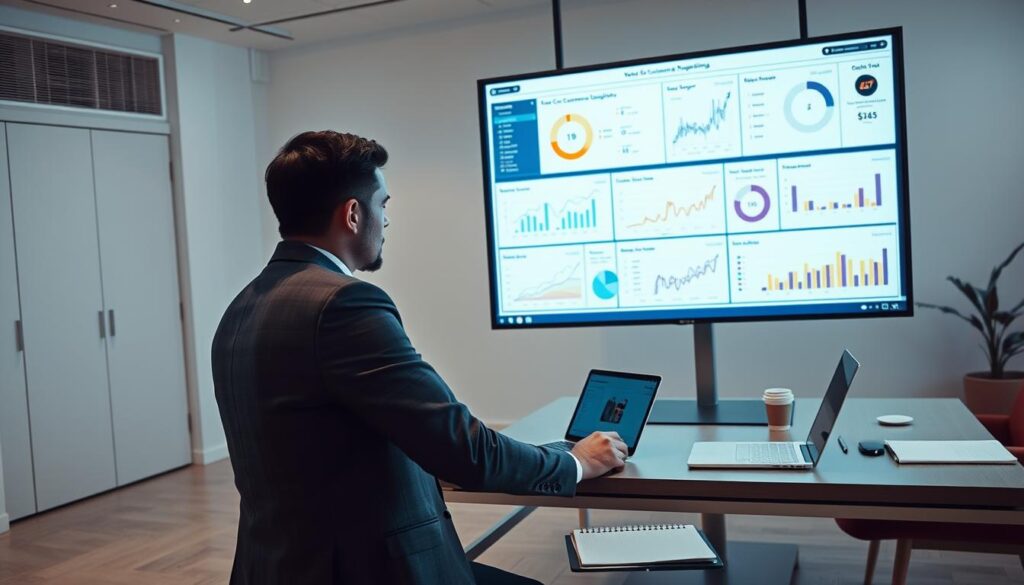Fact: using three or more channels can lift order rates by 494% versus single-channel campaigns. That scale exposes a simple truth — complexity kills conversions.
We see bloated tech stacks, siloed data, and fragmented customer experience draining ROI and inflating CAC. We build a clear fix: a unified system that aligns data, content, and channels to reclaim profitable growth.
Our approach pairs integrated technology and disciplined processes to enable real-time personalization across online and offline touchpoints. Leaders who adopt this path report 10–15% lifts in retention and revenue and 10–30% cuts in marketing costs.
This piece is for high-ticket brands that need a premium, scalable funnel that converts discerning customers across devices — without wasting time or budget. We outline a stepwise plan from VOC and segmentation to message choreography, automation, and attribution.
We promise actionable, enterprise-grade playbooks you can deploy now to compound revenue across the full customer journey.
Key Takeaways
- Complexity suppresses conversions; a unified funnel restores profitable growth.
- Integrated tech plus process yields measurable lifts in retention and revenue.
- Three-plus channels dramatically increase order rates versus single-channel efforts.
- This guide serves high-ticket brands seeking scalable, ROI-driven systems.
- Expect step-by-step frameworks, metrics, and governance you can deploy fast.
The new reality: why complexity is killing conversions and how omnichannel fixes it
Complex tech and disjointed data are quietly costing premium brands conversions and trust. Marketers spend up to 50% of their time on execution, leaving little room for strategy or creative work.
Bloated technology stacks create repeated handoffs, errors, and lost revenue. Siloed customer data blocks personalization and produces inconsistent experience across channels.
The double-edged sword of martech: bloated stacks, siloed data, and fragmented experiences
We quantify the drag: execution consumes half of a team’s time while disconnected tools multiply mistakes.
- Failure loop: siloed data prevents personalization and loses high-intent customers.
- High-ticket stakes: affluent customers expect precision and speed; one mistimed message erodes lifetime value.
- The fix: a unified approach that links product, sales, and customer data to enable real-time engagement across touchpoints.
| Problem | Impact | Outcome with unified approach |
|---|---|---|
| Execution-heavy teams | 50% time spent on manual tasks | Teams focus on strategy; faster time to value |
| Siloed customer data | Inconsistent experience across channels | Personalized, real-time messages that retain customers |
| Fragmented technology | Errors, handoffs, missed revenue | Fewer tools, secure integrations, improved results |
We position Macro Webber as the partner that unifies data, governance, and activation so brands scale consistent, revenue-driven engagement.
Omnichannel vs multichannel vs cross-channel: definitions that drive strategy
How you organize channels dictates whether your brand feels coherent or chaotic. We define three models so executives can choose the one that delivers measurable outcomes.
What omnichannel marketing is—and isn’t
Multichannel means you use many marketing channels, but each operates in its own lane. It is simple to launch but hard to scale personalization or measure true ROI.
Cross-channel ties some systems together. Campaigns can hand off to another channel, yet there is still no single customer profile or unified decisioning layer.
Omnichannel unifies data into one record. That record powers consistent decisions and personalized messages across devices and stages. It prevents common errors—like a buyer getting a promo email for an item they already purchased the day before.
“A unified profile is the difference between seamless revenue and wasted spend.”
Key differences and business impact
- Multichannel: fast to start, weak personalization, poor attribution.
- Cross-channel: better coordination, still limited by fragmented profiles.
- Omnichannel: single truth for customers, real-time decisioning, protected margin.
| Model | Data | Customer impact | Business outcome |
|---|---|---|---|
| Multichannel | Siloed | Inconsistent brand experience | Low personalization, high CAC |
| Cross-channel | Partially connected | Better handoffs, gaps remain | Improved engagement, limited ROI visibility |
| Omnichannel | Unified profile + AI | Seamless experience across channels | Higher retention, measurable margin protection |
We advise choosing omnichannel when your mandate is premium service and measurable ROI. Align governance, KPIs, and operating models up front so execution can scale without losing the brand experience.
Omnichannel Marketing Strategy
A premium buyer notices every gap; our work removes them before they cost loyalty. We shift the plan from brand-first ops to a customer-centered model that links intent, action, and outcome.
From brand-first to customer-centric: aligning around the customer journey
We reframe the enterprise by mapping five lifecycle stages: Acquisition, Conversion, Growth, Retention/Loyalty, and Win-back.
Every stage earns investment only when tied to measurable impact. Teams share goals, incentives, and playbooks so handoffs are seamless and accountable.
- Data spine: first-party profiles power consented personalization that compounds over time.
- Choreography: each touch advances momentum rather than repeating context.
- Governance: clear escalation to human service for high-value customers.
Nonlinear journeys and seamless handoffs across touchpoints
Customers move fluidly—social discovery can end in-store purchase the same day. We design for that fluidity.
Preferences and actions captured on one channel must update the profile instantly so the next interaction feels informed and white-glove.
“Design for movement, not boundaries — customers do not follow org charts.”
| Lifecycle Stage | Primary Goal | Key Metric |
|---|---|---|
| Acquisition | Drive qualified traffic | Visibility / CAC |
| Conversion | Turn interest into purchase | Conversion rate |
| Growth | Increase spend and engagement | Average order value |
| Retention/Loyalty | Secure repeat customers | Repeat rate / CLTV |
| Win-back | Recover lapsed customers | Reactivation rate |
Present-day trends shaping customer journeys in the United States
Consumers now move between apps, stores, and browsers in minutes, creating new demands for seamless engagement. This behavior forces premium brands to adopt faster decisioning and tighter data flows.

AI, automation, and conversational channels
AI and automation scale personalization without adding headcount. We use predictive models to reduce manual work and free teams to focus on creative priorities.
Conversational apps like WhatsApp can host full purchase threads. That capability turns support into commerce and opens new revenue paths within a single chat.
Cross-device behavior and the rise of phygital channels
Shoppers research on mobile, compare on desktop, and convert in-store. We design for continuity so online actions inform in-person service and inventory choices.
Phygital experiences marry digital signals with in-store personalization to lift conversion and lifetime value.
More integrated channels drive better ROI
Coordinated use of three or more channels delivers materially higher order rates—Omnisend shows a 494% lift versus single-channel efforts.
Our approach prioritizes unified profiles so extra channels add engagement and revenue, not noise.
| Trend | Impact on customer | Business result |
|---|---|---|
| AI + automation | Faster personalization, fewer errors | Lower time-to-value; improved margins |
| Conversational commerce | End-to-end journeys in messaging | New sales channel; higher conversion |
| Phygital experiences | Seamless online offline interactions | Higher in-store conversion; better retention |
Step one: collect insights and voice-of-customer to map the real journey
Start by walking every customer path your brand exposes—website, app, social, store, and support. We record where customers stall, which messages contradict, and which channels fail to pass intent forward.
Walk the path
We mystery-shop our funnel end-to-end. This reveals latency, broken links, and inconsistent content that erode conversion.
VOC inputs
Deploy structured programs—short surveys, review mining, and moderated focus groups—to capture stated needs and emotions. Pair those with frontline interviews from store cashiers and support agents.
- Log where customers interact brand on social media, app, web, and in-store.
- Capture quantitative signals: views, searches, add-to-cart, and drop-off points.
- Audit accessibility, load speed, and checkout flow to protect baseline experience.
- Codify insights in a shared repository so product, marketing, and service act on the same map.
Actionable outcome: convert VOC into prioritized fixes tied to revenue impact—reduce checkout drop rate, cut support handle time, and increase repeat purchase by focusing on high-friction touchpoints.
Step two: analyze, segment, and prioritize customer needs
We convert scattered customer signals into crisp segments that drive revenue. The goal is simple: turn raw events into prioritized work that raises CLTV and lowers acquisition spend.
From raw data to segments: behaviors, value, and intent signals
We segment by value (RFM/CLTV), behavior (browse, cart, purchase cadence), and intent signals.
This creates cohorts we can target profitably across channels.
Personas and journeys tailored to high-value customers
Personas must be data-grounded, not wishful thinking. We map each persona to preferred channels, content, and service levels. Then we map micro-journeys for high-value cohorts to remove friction and speed the next-best action.
“Segment with discipline: prioritize needs that unlock cross-sell, upsell, and loyalty.”
- Translate insights into channel-specific hypotheses and content themes for A/B testing.
- Define eligibility and suppression rules so customers see only relevant offers.
- Set success metrics per segment—conversion lift, AOV uplift, repeat rate—to prove results.

| Segment | Primary Signal | Priority Action | Success Metric |
|---|---|---|---|
| High CLTV repeaters | Purchase frequency & AOV | Personalized VIP offers | Repeat rate ↑, CLTV ↑ |
| Browse-to-cart window | Cart adds, browse depth | Timed cart recovery via web/app | Conversion rate ↑ |
| Early intent leads | Search queries & product views | Educational content + targeted ads | Acquisition cost ↓, LTV growth |
Step three: design the omnichannel funnel across online and offline channels
A high-performing funnel assigns clear roles to each touchpoint so customers move forward without friction. We map the five lifecycle stages—Acquisition, Conversion, Growth, Retention/Loyalty, and Win-back—and attach channel responsibilities to each stage.
Acquisition to loyalty: five stages of the customer journey
Assign awareness to paid and social, consideration to the web and app, conversion to email and SMS, growth to personalized offers, and loyalty to service and exclusives. Each stage has a single primary metric and one activation play.
Channel roles: email, paid/social, web, app, and in-store experiences
Email drives onboarding, education, replenishment, and VIP exclusives. Paid and social build qualified awareness. The site and app host consideration and rapid personalization. In-store executes clienteling, pickups, and white-glove returns.
Message choreography: the right content at the right time across channels
We connect triggers to behavior—browse, cart, category interest, or service events—then sequence content so messages do not repeat. Guardrails include frequency caps, suppression after conversion, and escalation to human outreach for high-value signals.
| Stage | Primary Channel | Action |
|---|---|---|
| Acquisition | Paid / social | Targeted creative to seed interest |
| Conversion | Email / SMS | Time-bound offers and cart reminders |
| Retention | Service / email | VIP offers, replenishment, and clienteling |
Operationalize: document playbooks per stage, sync creative across devices, and measure handoff success so the funnel scales without adding noise or risk to the brand.
Step four: build the data and technology foundation
A resilient data foundation lets brands personalize at scale without adding headcount. We prioritize systems that give marketers control, protect privacy, and speed time to value.
Unifying product, sales, and customer data for 1:1 personalization
We consolidate product catalog, CRM sales events, and behavioral signals into a persistent profile. That profile powers real-time recommendations and personalized service.
Identity resolution ties sessions and purchases into a single record so every channel sees the same customer.
CRM/CDP, consent, privacy, and first-party data
Deploy a CDP/CRM architecture that minimizes IT dependency and respects consent. Capture consent transparently and apply regional controls.
Privacy-by-design means data minimization and clear retention policies so compliance and trust scale with volume.
Automation and AI to orchestrate real-time engagements
Implement event streams for web, app, and store triggers. Operationalize automation and AI for next-best-action, send-time optimization, and product ranking.
Finally, instrument unified analytics and attribution at the foundation so decisions map directly to results.
| Component | Role | Key Benefit |
|---|---|---|
| Persistent profile | Unifies product, sales, behavior | 1:1 personalization across channels |
| CDP / CRM | Activation & consent governance | Marketer autonomy; faster time to value |
| Event streams & AI | Real-time triggers and decisioning | Higher conversion, lower latency |
| Unified analytics | Attribution & reporting | Connects activity to business results |
Orchestration playbooks for seamless brand experience across touchpoints
Our playbooks map precise triggers and channel rules so every customer move becomes opportunity. We outline tactical flows that protect experience and lift revenue.
Cart and browse abandonment flows across email, SMS, and retargeting
We build tiered abandonment sequences that escalate by value. Start with a soft browse nudge, then trigger dynamic product email with urgency timers for high-value carts.
Escalate to SMS only for high-intent customers. Use retargeting on social media to close the gap without repeating the same creative.
Loyalty and post-purchase: driving repeat purchases and retention
Post-purchase flows move beyond receipts. Send education, care tips, and timed replenishment to prompt the next order.
We design tiers with experiential rewards and early access that match a premium brand position to raise repeat rates and loyalty.
In-store to digital: bridging offline channels with online personalization
Connect receipts and POS events to profiles so in-store visits trigger tailored digital offers. This phygital experience links service touchpoints to measurable upsell opportunities.
Conversational journeys: end-to-end interactions in messaging apps
Deploy WhatsApp and similar apps for discovery, conversion, and support in a single thread. Track response time SLAs, escalate high-value cases, and log outcomes to the customer profile.
- Dynamic product feeds in email and retargeting to increase conversion.
- Coordinated cadence across channels to cut fatigue and boost incremental lift.
- Adaptive win-back flows that change offer and cadence by churn risk.
| Playbook | Trigger | Primary KPI |
|---|---|---|
| Abandonment | Cart add but no purchase | Recovery rate |
| Post-purchase | Order placed | Repeat rate |
| In-store follow-up | POS event / receipt | Omnichannel AOV |
Measurement, attribution, and proving revenue impact
Measurement must tie every campaign to revenue so leaders can redirect spend confidently. We make analytics a business tool, not a reporting chore. That clarity changes how teams prioritize tests and media buys.
Unified analytics to track campaigns and customer journeys
We stitch touchpoints into one platform so a customer’s path is visible from first click to repeat order.
Standard KPIs align teams on revenue outcomes, not vanity metrics. Executive dashboards show contribution by channel, time, and cohort.
Attribution approaches that fit cross-channel strategies
We pick models that reflect reality: data-driven or position-based attribution for coordinated channels, not last-click bias.
Average customers touch seven points before converting. We quantify incremental lift with geo holdouts, matched-market tests, and audience splits.
- Report multi-touch impact to protect assisted conversion investments.
- Measure time to value for pilots and reallocate budget dynamically.
- Integrate product margin so optimizations favor profitable growth, not just volume.
| Measure | Why it matters | Output |
|---|---|---|
| Unified attribution | Shows true contribution | Revenue maps by channel |
| Incremental tests | Proves lift | Budget reallocation rules |
| Executive dashboards | Speeds decisions | Quarterly investment plan |
We deliver executive-ready reporting that proves business results and guides the next-best investment cycle.
Change management: teams, processes, and governance that scale
Durable transformation begins with a clear governance model and repeatable rituals. We build operating principles that align teams, protect the brand, and speed time to results.
Marketing-IT alignment, security, and data stewardship
We align marketing and IT on a shared roadmap, security standards, and data governance for durable execution.
Enforceable controls include consent workflows, access rules, and audit logs so customers trust every interaction.
We favor all-in-one platforms with built-in analytics for the C-suite and secure connectors to simplify integration and speed time to value.
Operating models: centralized strategy, decentralized execution
Centralize strategy and guardrails while empowering local teams to run fast with playbooks and templates.
- Define RACI across content, data, and channel operations to remove gaps.
- Stand up a center of excellence to own training, QA, and best practices.
- Use sprint reviews, test libraries, and rollback plans to protect brand equity.
We link incentives to shared KPIs—revenue, CLTV, and satisfaction—so teams prioritize the right work and deliver measurable results.
Roadmap: from pilot to full-funnel omnichannel at enterprise scale
We begin with rapid pilots that prove revenue and create momentum for scale. That urgency keeps teams focused and leadership aligned on clear, measurable wins.
Quick wins: prioritize high-impact touchpoints and segments
Start small but with intent. We pilot browse and cart recovery, onboarding, and post-purchase flows. These yield fast revenue and strong signal quality.
Target high-value customers first so tests show clear results. Pair each pilot with unified analytics and one KPI—recovery rate, repeat rate, or time-to-next-order.
Scaling lessons: iterate, optimize, and expand channels over time
Sequence tech enablement: identity, event streams, and journeys come first. Add advanced AI and conversational tools in a later step.
Expand channels only when measurement and ops can maintain excellence. Set time-bound milestones and decision criteria so teams know when to scale.
We codify wins into reusable playbooks, automate them, and apply localization frameworks for global rollouts. This approach de-risks growth and accelerates tangible results for the brand.
Conclusion
When data, content, and automation align, conversion and loyalty follow. We recap the system: sharp insight, disciplined segmentation, an omnichannel marketing strategy, and a resilient data/tech backbone that drives measurable business results.
Leaders see 10–15% lifts in retention and revenue, 10–30% cost savings, and 494% higher order rates with three-plus channels. Better retention can boost profits by 25–95% from small gains in repeat business.
Now is the moment: rising media costs make first-party data and automation a durable edge. Our WebberXSuite™ and the A.C.E.S. Framework compress time to value and de-risk scale.
Book a Growth Blueprint session today to surface quick wins and a 90-day plan. Early movers capture outsized market share while competitors stall. We tie every initiative to unified analytics and clear ROI.



